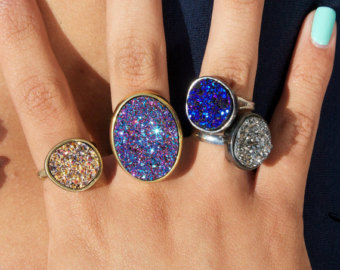I'm not going to get into the technical details of what comprises drusy, other than to say it's used to refer to encrustations or clusters of minute crystals. You will sometimes see the term spelled druzy, druse or drusies. All these terms refer to the same thing - tiny crystals that form within or on the surface of other minerals. The druzy quartz gems grow slowly over millions of years and are found as the very last layer of growth on agate or another colorful base. By far the most commonly found drusy is quartz (agate or chalcedony), but many other gem types exist in this form. Other types of drusy include uvarovite garnet, rainbow pyrite, rainbow hematite, chrysocolla, calcite, demantoid garnet, melanite garnet and turquoise.
In drusy gemstones, quality is determined not just by color, weight and clarity, but also by the size and evenness of crystal coverage. The evenness with which the matrix is covered is an important value factor. Good drusy's are relatively rare, especially in non-quartz species.
Drusy can be quite delicate compared to typical faceted and cabochon gemstones. The toughness of each drusy piece depends on the nature of the crystals themselves and the matrix in which they are embedded. For example, quartz drusy is relatively durable while calcite drusy is quite fragile.
One of the perks to druzy stones is that they are not as expensive as big faceted gemstones and they have sparkle and great color and it can be cut into various shapes to make some very interesting, unique and beautiful jewelry.
How to care for drusy:
If needed, you can use warm, soapy water and a soft brush to gently clean your drusy jewelry, then rinse and dry. Do not expose the stone to household chemicals or chlorine, and to best preserve your jewelry, do not wear it in the shower.



